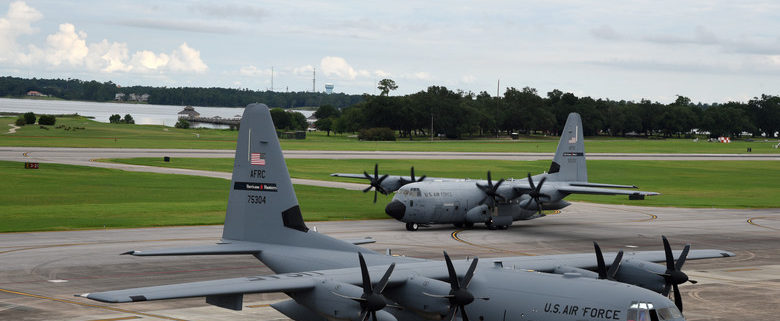Hurricane Hunters fly Hurricane Dorian
By Tech. Sgt. Christopher Carranza, 403rd Wing Public Affairs / Published August 29, 2019
A WC-130J Super Hercules from the 53rd Weather Reconnaissance Squadron, known as Hurricane Hunters, taxis to the runway Aug. 25, 2019 at Keesler Air Force Base, Miss. The Hurricane Hunters staged their aircraft in the Dutch Caribbean island, Curaçao and began flying into Hurricane Dorian Aug. 26. (U.S. Air Force photo by Jessica L. Kendziorek)
KEESLER AIR FORCE BASE, Miss. (AFNS) —
Three WC-130Js and one C-130J Super Hercules aircraft from the 403rd Wing departed Keesler Air Force Base Aug. 26 for the Dutch Caribbean island Curaçao to provide weather reconnaissance support for Hurricane Dorian.
“The three weather crews, assigned to the 53rd Weather Reconnaissance Squadron, have been flying missions as of last night,” said Maj. Kendall Dunn, 53rd WRS pilot. “The tactical airlift crew, assigned to the 815th Airlift Squadron, is carrying extra cargo and aircraft parts to support the weather aircraft.”
According to the National Hurricane Center website, hurricane conditions are likely over parts of the Bahamas and the southeastern U.S. over the Labor Day weekend.
The Hurricane Hunters have been flying “fixed” missions. During a fixed mission, the aircraft collects weather data such as temperature, wind speed, wind direction, humidity and surface pressure. Aircrews fly through the eye of a storm four to six times to locate the low-pressure center and circulation of the storm. During each pass through the eye, they release a dropsonde, which collects weather data on its descent to the ocean surface, specifically gathering data on the surface winds and pressure.
Due to a lack of radar and weather balloons availability over the Atlantic Ocean, the 53rd WRS flies into the storms, gathers the data and provides this data to the NHC to assist with their forecasts and storm warnings by transmitting the information gathered via satellite communication approximately every 10 minutes.
The 53rd WRS’s operations area ranges from the meridian 55 degrees longitude line in the Atlantic Ocean to the International Dateline in the Pacific Ocean. They also support 24-hour continuous operations with the ability to fly up to three storms simultaneously and with a response time of 16 hours.
“As of now we’re flying missions out of Curaçao, but will be repositioning to fly out of Homestead (Air Reserve Base, Florida) as the storm gets closer to the U.S.,” Dunn said. “It’s like chess, this is the time where experience is crucial for planning and staging our mission. This is why reservists are invaluable to our mission.”




